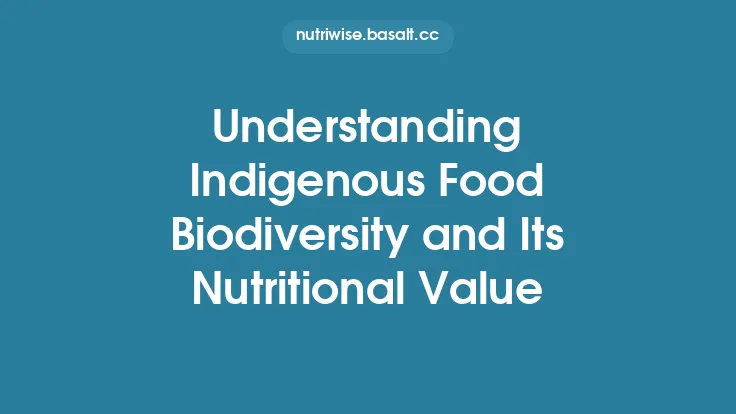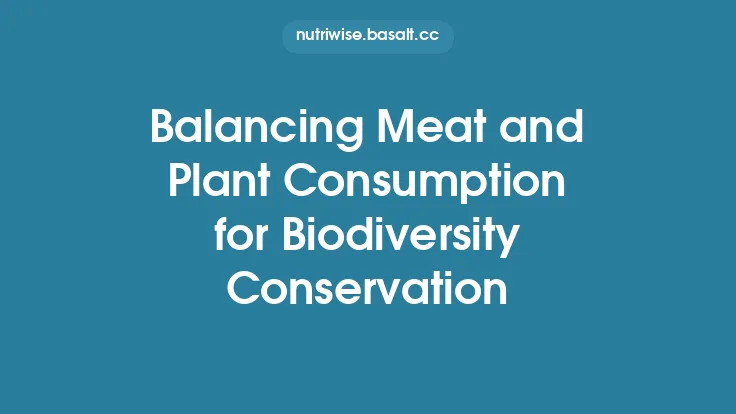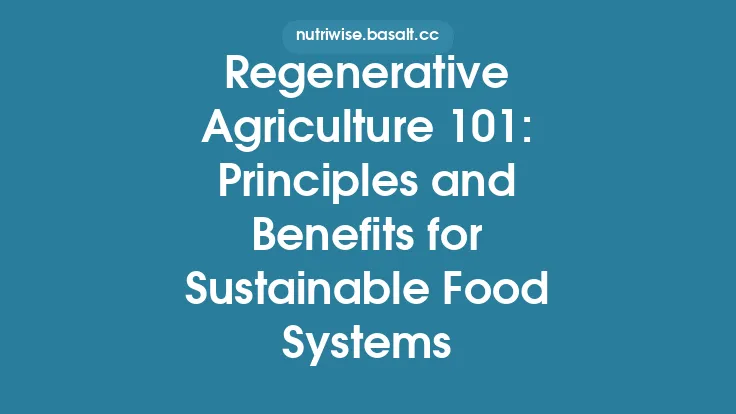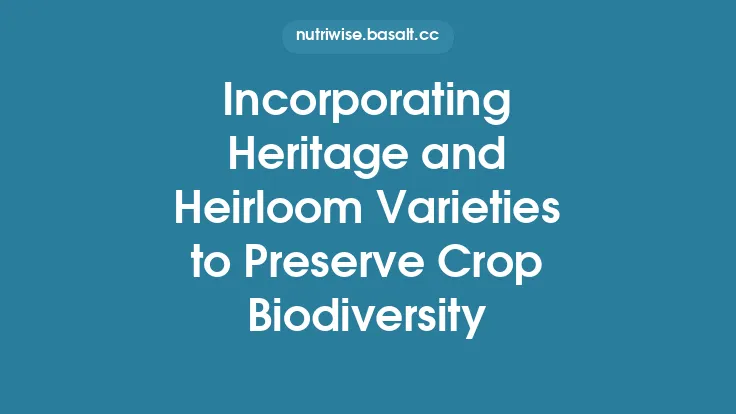Agroforestry, the intentional integration of trees, shrubs, and other woody perennials into agricultural landscapes, has emerged as a cornerstone of regenerative food production. By weaving together the ecological functions of forest ecosystems with the productivity of conventional crops, agroforestry creates a dynamic environment where plant nutrition, flavor complexity, and ecosystem health reinforce one another. This synergy not only lifts the intrinsic quality of the foods we eat but also cultivates a richer tapestry of wildlife, pollinators, and soil organisms. Below, we explore the mechanisms, design strategies, and broader implications of agroforestry practices that specifically target enhanced food quality and biodiversity.
Core Principles Guiding Agroforestry Design
- Multifunctionality – Each component (tree, shrub, herb, or crop) is selected for multiple roles: food production, habitat provision, microclimate regulation, and nutrient cycling.
- Spatial Complementarity – Vertical and horizontal layering reduces competition for light, water, and nutrients while creating niche habitats.
- Temporal Complementarity – Species with staggered phenologies (e.g., early‑season fruiting trees paired with mid‑season vegetables) smooth labor demands and resource use across the growing season.
- Ecological Connectivity – Corridors of woody vegetation link isolated habitats, facilitating movement of pollinators, predatory insects, and seed‑dispersing birds.
- Resilience Through Diversity – A broader species pool buffers the system against pests, diseases, and climatic extremes, thereby stabilizing yields and preserving quality.
Key Agroforestry Systems and Their Contributions to Food Quality
| System | Typical Tree/ shrub component | Primary Crop(s) | How Food Quality Is Enhanced |
|---|---|---|---|
| Alley Cropping | Fast‑growing nitrogen‑fixing trees (e.g., *Leucaena leucocephala, Gliricidia sepium*) | Row‑planted vegetables, cereals | Trees improve soil nitrogen availability, leading to higher protein content and more balanced mineral profiles in adjacent crops. |
| Silvopasture (Tree‑Based Grazing) | Deep‑rooted hardwoods (e.g., oak, chestnut) providing shade | Forage grasses, legumes | Shade reduces heat stress on forage, preserving chlorophyll and increasing soluble sugars, which translate into more palatable, nutrient‑dense livestock products. |
| Windbreaks and Shelterbelts | Evergreen conifers or mixed‑species hedgerows | Field crops (corn, soy, wheat) | Wind reduction lowers evapotranspiration, maintaining leaf turgor and enhancing photosynthetic efficiency, which can increase carbohydrate accumulation in grains. |
| Forest Farming (Understory Cropping) | Shade‑tolerant trees (e.g., walnut, pecan) | Medicinal herbs, shade‑loving vegetables (e.g., mushrooms, leafy greens) | Diffused light slows leaf expansion, concentrating secondary metabolites (flavonoids, terpenes) that boost flavor and antioxidant capacity. |
| Riparian Buffers | Native willows, alders, and fruiting shrubs | Flood‑plain crops (rice, sorghum) | Buffer zones filter runoff, reducing excess salts and heavy metals that can impair taste and nutrient uptake. |
| Multi‑Strata Agroforestry | Combination of canopy, sub‑canopy, and shrub layers (e.g., cacao under *Inga spp., coffee under Erythrina*) | Perennial cash crops (cacao, coffee) | Diverse root zones improve micronutrient availability (Zn, Fe, Mn), which are directly linked to bean and bean‑like flavor development. |
Tree‑Crop Interactions that Elevate Nutrient Profiles
- Mycorrhizal Networks
Mycorrhizal fungi colonize the roots of both woody and herbaceous plants, forming a common mycelial network (CMN). Through this network, trees can translocate phosphorus, potassium, and micronutrients to neighboring crops, especially during periods of low soil availability. Studies have shown that crops linked to mycorrhizal trees often exhibit higher concentrations of essential minerals such as magnesium and calcium, which are critical for human bone health and metabolic function.
- Nitrogen Fixation and Transfer
Leguminous trees (e.g., *Albizia, Sesbania*) host rhizobial bacteria that convert atmospheric N₂ into ammonia. A portion of this fixed nitrogen is released into the soil via leaf litter, root exudates, and senescent root turnover. Crops growing in proximity can assimilate this nitrogen, resulting in increased protein content and improved amino acid balance, particularly in cereals and legumes.
- Allelopathic Modulation
Certain tree species exude compounds that suppress weed germination while simultaneously stimulating beneficial secondary metabolite pathways in adjacent crops. For instance, the phenolic acids released by *Eucalyptus* can upregulate phenylpropanoid synthesis in understory vegetables, enhancing antioxidant levels without compromising yield.
- Microclimate Buffering
Tree canopies moderate temperature extremes and solar radiation intensity. Cooler daytime temperatures and reduced night‑time heat loss preserve chlorophyll integrity, leading to higher chlorophyll‑a concentrations in leafy greens—a proxy for increased vitamin K and lutein content. Moreover, moderated humidity reduces transpiration stress, allowing plants to allocate more carbon to soluble sugars, which improve taste and caloric density.
Biodiversity Gains from Integrated Tree Canopies
- Pollinator Habitat
Flowering trees and shrubs provide continuous nectar and pollen resources throughout the season, supporting a diverse assemblage of bees, butterflies, and hoverflies. This sustained foraging landscape improves pollination efficiency for fruit‑bearing crops, directly influencing fruit set, size, and sugar accumulation.
- Predatory and Parasitic Insect Refuge
Structural complexity of tree branches and leaf litter creates refugia for lady beetles, lacewings, and parasitic wasps. These natural enemies suppress aphids, caterpillars, and other herbivores, reducing the need for chemical interventions that can degrade nutrient quality.
- Avian Diversity
Cavity‑nesting birds (e.g., woodpeckers, owls) find nesting sites in mature trees, while fruit‑bearing species attract frugivorous birds that aid in seed dispersal. Avian predation on pest insects further contributes to crop health, indirectly preserving the biochemical integrity of harvested produce.
- Soil Fauna Enrichment
The continuous input of leaf litter and woody debris fuels a robust detritivore community (earthworms, springtails, millipedes). Their bioturbation activities improve soil aeration and organic matter turnover, fostering a fertile medium that supports higher nutrient uptake by crops.
Design Considerations for Maximizing Food Quality
- Species Selection Aligned with Crop Needs
- Choose nitrogen‑fixing trees for nitrogen‑limited soils.
- Pair deep‑rooted trees (e.g., *Eucalyptus*) with shallow‑rooted vegetables to avoid competition for water while exploiting complementary nutrient zones.
- Incorporate fruit‑bearing trees that provide additional harvests without displacing primary crops.
- Optimizing Spatial Arrangement
- Alley Width: Typically 5–10 m between rows of trees allows sufficient light penetration for most row crops while maintaining canopy benefits.
- Tree Spacing: 8–12 m between trees in an alley reduces root overlap and ensures adequate canopy development.
- Vertical Stratification: Position shade‑tolerant understory crops beneath a mid‑canopy layer, with a high canopy above to capture excess solar radiation.
- Timing of Pruning and Harvest
- Conduct light pruning during the early vegetative stage of the crop to increase light availability without fully exposing the soil.
- Schedule tree fruit harvests to avoid coinciding with peak crop maturity, thereby minimizing labor bottlenecks and ensuring optimal post‑harvest handling.
- Soil Amendments and Mulching
- Apply organic mulches derived from tree prunings to conserve moisture and slowly release nutrients.
- Avoid synthetic fertilizers that could disrupt the natural nutrient exchange pathways central to agroforestry’s regenerative benefits.
- Monitoring Plant Health Indicators
- Use leaf chlorophyll meters (SPAD) and portable spectrometers to track nutrient status across the canopy gradient.
- Conduct periodic soil tests for available phosphorus, potassium, and micronutrients to fine‑tune tree‑crop interactions.
Economic and Social Implications
- Diversified Income Streams
The simultaneous production of timber, fruit, nuts, and understory crops spreads market risk and can increase farm profitability. High‑value niche products such as shade‑grown cacao or specialty mushrooms often command premium prices, reflecting their superior sensory qualities.
- Labor Efficiency
Integrated systems reduce the need for separate field operations (e.g., separate planting and harvesting of cover crops) and can lower overall labor inputs when designed with mechanization in mind. Tree rows can serve as pathways for equipment, simplifying field access.
- Community Resilience
Agroforestry landscapes provide ecosystem services—pollination, pest regulation, and climate buffering—that benefit neighboring farms and local food systems. The presence of edible trees in public spaces also enhances food sovereignty and cultural connections to the land.
Challenges and Future Directions
- Initial Capital and Knowledge Barriers
Establishing tree components requires upfront investment and a longer time horizon before full returns are realized. Extension services and farmer field schools are essential for disseminating best‑practice designs.
- Balancing Light and Competition
Overly dense canopies can shade out understory crops, reducing yields and potentially compromising nutrient accumulation. Ongoing research into species‑specific light attenuation coefficients will aid in predictive modeling of optimal canopy density.
- Policy Incentives
Inclusion of agroforestry in agri‑environmental schemes, carbon credit markets, and biodiversity offset programs can provide financial incentives that accelerate adoption while preserving the focus on food quality.
- Technological Integration
Remote sensing (LiDAR, multispectral imaging) can map canopy structure and health, enabling precision management of light distribution and early detection of stressors that could affect crop nutrient composition.
Concluding Thoughts
Agroforestry stands at the intersection of ecological stewardship and culinary excellence. By thoughtfully integrating trees and shrubs into cropping systems, producers can harness natural processes that enrich the nutritional profile, flavor complexity, and overall quality of the foods we consume. Simultaneously, these practices weave a resilient web of biodiversity—supporting pollinators, beneficial insects, birds, and soil organisms—that underpins long‑term ecosystem health. As research deepens our understanding of tree‑crop synergies and policy frameworks evolve to reward multifunctional landscapes, agroforestry is poised to become a defining pillar of regenerative agriculture, delivering both delicious, nutrient‑dense foods and thriving, biodiverse environments.





